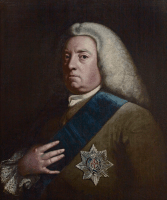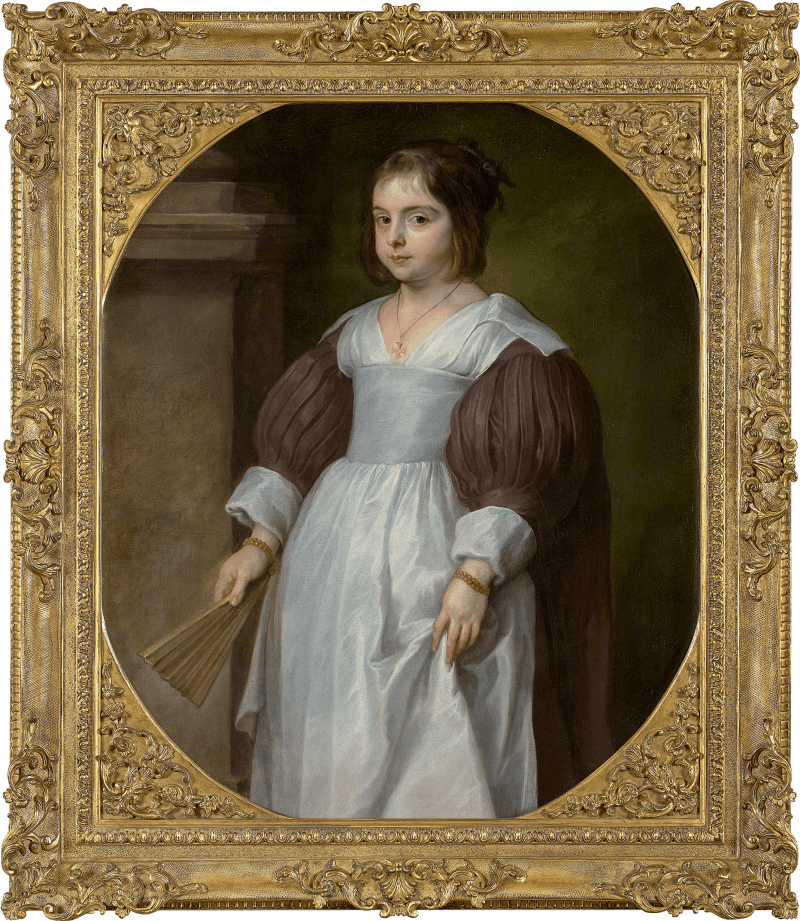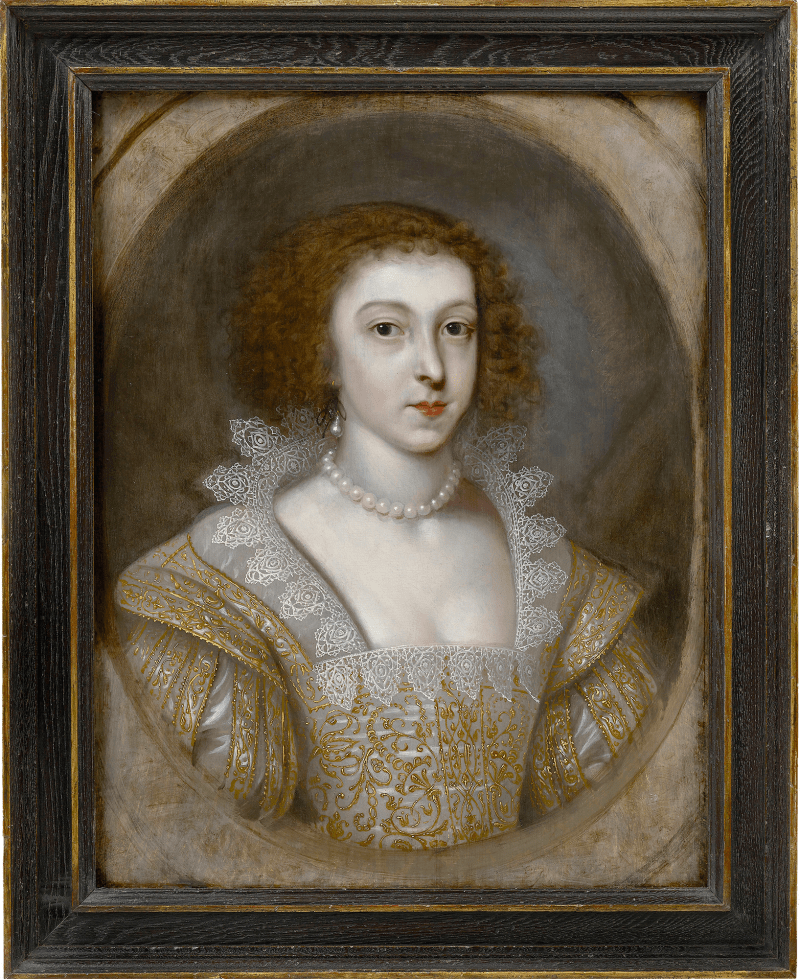This recently discovered portrait by Sir Joshua Reynolds (1723-1792) depicts William Cavendish, 3rd Duke of Devonshire (1698-1755), a prominent politician, fellow of the Royal Society, and founding governor of the Foundling Hospital. The emergence of this portrait, which until recently had lost the identity of both artist and subject, enables us to expand the recorded iconography of Cavendish whilst also allowing a deeper understanding of Reynold’s style of painting in the early stages of his career.
Reynolds painted Devonshire in 1753, within a year of his return from his Grand Tour in Italy, as evidenced by a signed and dated three-quarter length version of the present work at Chatsworth. In a letter to the sculptor Joseph Wilton (1722-1803) – a friend from his Tour who had still yet to return – he boasted of his recent clientele, among them the Duke. In the letter, Reynolds writes his having recently ‘finished the head of the Duke of Devonshire he himself...
This recently discovered portrait by Sir Joshua Reynolds (1723-1792) depicts William Cavendish, 3rd Duke of Devonshire (1698-1755), a prominent politician, fellow of the Royal Society, and founding governor of the Foundling Hospital. The emergence of this portrait, which until recently had lost the identity of both artist and subject, enables us to expand the recorded iconography of Cavendish whilst also allowing a deeper understanding of Reynold’s style of painting in the early stages of his career.
Reynolds painted Devonshire in 1753, within a year of his return from his Grand Tour in Italy, as evidenced by a signed and dated three-quarter length version of the present work at Chatsworth. In a letter to the sculptor Joseph Wilton (1722-1803) – a friend from his Tour who had still yet to return – he boasted of his recent clientele, among them the Duke. In the letter, Reynolds writes his having recently ‘finished the head of the Duke of Devonshire he himself and all the family say it is the only like picture he ever had of himself’; Reynolds adds, significantly, that ‘there are many copies bespoke’.[1]
This was a remarkably glowing response, especially given Cavendish was a shrewd patron of the arts, and it no doubt improved Reynolds’ reputation considerably within the higher tiers of society. Reynolds seems to have been particularly proud of his three-quarter length likeness of the Duke – to which this portrait is related – as it was engraved in mezzotint by John Faber (c.1695-1756) in the year of the Duke’s death in 1755.
It may be that the ‘many copies bespoke’ referred to in Reynolds’s letter relate to an overlooked entry in Reynolds’ pocketbook, which may also reveal who commissioned the present work. Opposite the week beginning 25 December 1758 is written: ‘copy of the late Duke of Devon for the present Duke. Do. a head for Ld J. Cavendish’. Recent scholarship has interpreted this entry as relating to a single commission; however, it almost certainly relates to two separate requests.[2] The ‘Do [ditto]’ indicates that the head for Lord J. Cavendish (John Cavendish, the younger brother of the 4th Duke and youngest son of the sitter) is additional to rather than being the same as the first copy. This first copy was commissioned by ‘the present Duke’ (who by this date was William Cavendish, 4th Duke of Devonshire), and is almost certainly the three-quarter length version later owned by his third son George, 1st Earl of Burlington, which was sold through Sotheby’s in 1949.[3] The reference, moreover, to the ‘head’ suggests that this second work was of a different size than the first. During this period, Reynold would sometimes refer to a bust-length canvas such as this, typically measuring 30 x 25 inches, as a ‘head’, and the larger 50 x 40-inch canvas as a ‘half-length’.
Indeed, it might be noted that Reynolds’s first reference in his letter to Wilton is somewhat unclear on this point. It has always been assumed that Reynolds’s reference to having ‘finished the head of the Duke of Devonshire’ refers to the head of the signed and dated 1753 work at Chatsworth; however, given the ‘many copies’ that Reynolds describes as having already been ordered, it is not implausible that the original was, in fact, a bust-length portrait that was then later used as the basis for the larger half-length. Certainly, the fact that another version of this larger portrait is also signed and dated to 1753 means that the question of the prototype remains somewhat open to question.
The technical virtuosity of this work is a testament to the high level of quality maintained by Reynolds in the years before his establishment of a large and ambitious studio. At the peak of his career, it is doubtful that Reynolds had much involvement with the reproduction of portrait copies, a task left instead to one of his many talented studio assistants. In the 1750s, however, when trying to solidify his reputation as an eminent portrait painter, it seems very unlikely that Reynolds would have delegated the task of replicating an earlier portrait of such a prominent subject. This much is evident in the remarkable confidence observed in the handling of the facial features and hands in the present work, which reveal an artist not bound by the task of mere copying, but instead free to interpret representation for themselves.
The 3rd Duke of Devonshire was born into a family of impeccable and impressive Whig credentials. Sir Robert Walpole (1676-1745) was said to have been inconsolable on his death, such had been the fierceness of his loyalty to the Walpole cause. The second duke had also been a noted collector of art, building up an impressive collection at his seat at Chatsworth and his residence of Devonshire House in London.
Like his father, the third duke was active in politics, becoming a Member of Parliament in 1721 where he served until his father’s death in 1729, which saw him elevated to the House of Lords. Throughout his career, he also spent seven years serving as Lord Lieutenant of Ireland. Like his father before him, he too kept up a close association with Walpole, from whose collection he purchased works of art, including one by Sir Anthony Van Dyck. Among Devonshire’s more notable achievements was his patronage of the fashionable architect William Kent (c.1686-1748), whom he commissioned to rebuild Devonshire House in the cutting-edge Palladian style following its destruction by fire in 1733.
With his wife, Catherine (d. 1777), the eldest daughter of John Hoskins of Oxted, Surrey (whom he married in 1718), Devonshire fathered seven children. His eldest son, William, became the fourth Duke of Devonshire on his death in 1755, the same year in which he became prime minister, although his ministry was only to last for some two years.
[1] J. Ingamells, J. Edgcumbe (eds.), The Letters of Sir Joshua Reynolds (New Haven and London, 2000), no. 9, pp. 13-15.
[2] D. Mannings, Sir Joshua Reynolds: A Complete Catalogue of his Paintings, (New Haven and London, 2000), P.126, Cat.334a.
[3] Sotheby’s 22 June 1949, lot 48. See D. Mannings, p. 126, Cat.334.











